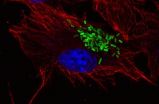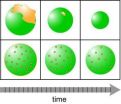(Press-News.org) A new study by researchers at Imperial College London has identified a way in which Salmonella bacteria, which cause gastroenteritis and typhoid fever, counteract the defence mechanisms of human cells.
One way in which our cells fight off infections is by engulfing the smaller bacterial cells and then attacking them with toxic enzymes contained in small packets called lysosomes.
Published today (Thursday) in Science, the study has shown that Salmonella protects itself from this attack by depleting the supply of toxic enzymes.
Lysosomes constantly need to be replenished with fresh enzymes that are generated from a factory within our cells. These enzymes are carried from the factory along a dedicated transport pathway. After dropping off new enzymes at lysosomes, the transport carriers are sent back to the factory to pick up new enzymes.
In the study, led by Professor David Holden from the Department of Medicine and MRC Centre for Molecular Bacteriology and Infection, the group discovered that Salmonella has developed a specific way to interfere with the system that restocks the lysosomes with enzymes. They found that after bacteria have been engulfed by the cell, but before they are killed, Salmonella injects a protein that prevents the cell from recycling the transport carriers between the factory and the lysosome.
This means that Salmonella effectively cuts off the supply line of the enzymes that would otherwise kill it. As a result, the enzymes get re-routed out of the cell and the lysosomes lose their potency. Salmonella is then able to exploit the disarmed lysosomes by feeding off the nutrients they contain.
Professor Holden said: "This seems to be a very effective way for these harmful bacteria to interfere with our cell's defence mechanisms, and then exploit the defective lysosomes to their own benefit."
"Our challenge now is to understand in greater detail how the injected Salmonella protein works at the molecular level, and – potentially – to exploit our findings to develop more effective vaccines. This is especially important since many Salmonella strains are now resistant to antibiotics."
Different strains of Salmonella cause gastroenteritis, blood infections and typhoid fever, which together are responsible for millions of human illnesses and deaths each year.
INFORMATION:
The research project was funded with grants from the Medical Research Council and the Wellcome Trust.
Study finds how bacteria inactivate immune defenses
2012-11-16
ELSE PRESS RELEASES FROM THIS DATE:
Arthritis study reveals why gender bias is all in the genes
2012-11-16
Researchers have pieced together new genetic clues to the arthritis puzzle in a study that brings potential treatments closer to reality and could also provide insights into why more women than men succumb to the disabling condition.
Rheumatoid arthritis – which affects more than 400,000 people in the UK and about 1% of the world's population – is a complicated disease: lifestyle and environmental factors, such as smoking, diet, pregnancy and infection are thought to play a role, but it is also known that a person's genetic makeup influences their susceptibility to the ...
Uncommon features of Einstein's brain might explain his remarkable cognitive abilities
2012-11-16
TALLAHASSEE, Fla. Portions of Albert Einstein's brain have been found to be unlike those of most people and could be related to his extraordinary cognitive abilities, according to a new study led by Florida State University evolutionary anthropologist Dean Falk.
Falk, along with colleagues Frederick E. Lepore of the Robert Wood Johnson Medical School and Adrianne Noe, director of the National Museum of Health and Medicine, describe for the first time the entire cerebral cortex of Einstein's brain from an examination of 14 recently discovered photographs. The researchers ...
Study shows large-scale genomic testing feasible, impacts therapy
2012-11-16
DENVER – Targeted cancer therapy has been transforming the care of patients with non-small-cell lung cancer (NSCLC). It is now standard practice for tumor specimens from NSCLC patients to be examined for EGFR mutations and ALK rearrangements to identify patients for therapy with EGFR and ALK inhibitors, respectively. Now, researchers say large-scale genomic testing is feasible within the clinical workflow, impacting therapeutic decisions. The study is published in the December 2012 issue of the International Association for the Study of Lung Cancer's (IASLC) Journal of ...
Study shows bone metastases treatment can improve overall survival
2012-11-16
DENVER – It is common for patients initially diagnosed with lung cancer to have the cancer spread to sites like the liver, brain and bone. One of the most frequent sites of metastases is the bone, with an estimated 30 to 40 percent of patients with non-small-cell lung cancer (NSCLC) developing bone loss. A study published in the December 2012 issue of the International Association for the Study of Lung Cancer's (IASLC) Journal of Thoracic Oncology, shows that the bone metastases drug denosumab was associated with improved overall survival compared with zoledonic acid (ZA). ...
LLNL scientists assist in building detector to search for elusive dark matter material
2012-11-16
Lawrence Livermore National Laboratory researchers are making key contributions to a physics experiment that will look for one of nature's most elusive particles, "dark matter," using a tank nearly a mile underground beneath the Black Hills of South Dakota.
The Large Underground Xenon (LUX) experiment located at the Sanford Underground Research Facility in Lead, S.D. is the most sensitive detector of its kind to look for dark matter. Thought to comprise more than 80 percent of the mass of the universe, scientists believe dark matter could hold the key to answering some ...
Study: Cellphone bans associated with fewer urban accidents
2012-11-16
CHAMPAIGN, Ill. — Cellphones and driving go together like knives and juggling. But when cellphone use is banned, are drivers any safer?
It depends on where you're driving, a study by University of Illinois researchers says.
The study found that, long-term, enacting a cellphone ban was associated with a relative decrease in the accident rate in urban areas. However, in very rural areas, cellphone bans were associated with higher accident rates than would otherwise be expected.
"The main idea is to use the eye test when it comes to cellphone use," says study leader ...
Airborne particles smuggle pollutants to far reaches of globe
2012-11-16
RICHLAND, Wash. -- Pollution from fossil fuel burning and forest fires reaches all the way to the Arctic, even though it should decay long before it travels that far. Now, lab research can explain how pollution makes its lofty journey: rather than ride on the surface of airborne particles, pollutants snuggle inside, protected from the elements on the way. The results will help scientists improve atmospheric air-quality and pollution transport models.
The results also show that the particles that envelop pollutants also benefit from this arrangement. The new study in Environmental ...
Simplifying heart surgery with stretchable electronics devices
2012-11-16
Researchers at the McCormick School of Engineering are part of a team that has used stretchable electronics to create a multipurpose medical catheter that can both monitor heart functions and perform corrections on heart tissue during surgery.
The device marks the first time stretchable electronics have been applied to a surgical process known as cardiac ablation, a milestone that could lead to simpler surgeries for arrhythmia and other heart conditions. The researchers had previously demonstrated the concept to apply stretchable electronics to heart surgery, but with ...
Medical vital-sign monitoring reduced to the size of a postage stamp
2012-11-16
CORVALLIS, Ore. – Electrical engineers at Oregon State University have developed new technology to monitor medical vital signs, with sophisticated sensors so small and cheap they could fit onto a bandage, be manufactured in high volumes and cost less than a quarter.
A patent is being processed for the monitoring system and it's now ready for clinical trials, researchers say. When commercialized, it could be used as a disposable electronic sensor, with many potential applications due to its powerful performance, small size, and low cost.
Heart monitoring is one obvious ...
Video-article shows how to purify magnetic bacteria
2012-11-16
Magnetotactic bacteria, like Magnetospirillum magneticum, have evolved cellular processes that allow them to take up iron molecules to produce magnetic nanocrystals like magnetite. Since they were first discovered and isolated in 1975 by Robert Blakemore, scientists continue to be fascinated by these unique bacteria, whether as a means to isolate biogenic magnetite or to understand the evolutionary advantages of producing these minerals. A new video-article in JoVE (Journal of Visualized Experiments) details a procedure to purify and enrich samples of magnetotactic bacteria ...



